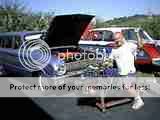I'm close to firing up the Clifford built perfomance six engine. It was built years ago in the Clifford shop when he was alive and mothballed in the crate. In the crate was a bottle of "Break-In fluid for blueprinted engines" . What is this stuff and how's supposed to be used?. (It tastes terrible  )
)

Any useful recomendations on the start-up since it's been setting awhile?. I was figuring straight SAE 20 with the "break-in fluid" . I've tried pre-oiling with a gearless dizzy and it does get oil up top fast. I need to run the cam in so I'm concentrating on the sensors - oil press, temp, vacuum and tach and these also are new and untested.




Jack Clifford, legendary six cylinder racer, record holder and engine builder's shop, performance built Ford 250 six engine- Jahns 10:1 Pistons, Clifford rods, Clifford Cam, line bored & balanced bottom end, Cloyes timing set, Fisher balancer, 1.88 int. valves, Ported and relieved, Offy 3X1 w/3 Holleys, Re-curved distrib., the works, a few mysteries...
Thanks,
Powerband 8)

Any useful recomendations on the start-up since it's been setting awhile?. I was figuring straight SAE 20 with the "break-in fluid" . I've tried pre-oiling with a gearless dizzy and it does get oil up top fast. I need to run the cam in so I'm concentrating on the sensors - oil press, temp, vacuum and tach and these also are new and untested.




Jack Clifford, legendary six cylinder racer, record holder and engine builder's shop, performance built Ford 250 six engine- Jahns 10:1 Pistons, Clifford rods, Clifford Cam, line bored & balanced bottom end, Cloyes timing set, Fisher balancer, 1.88 int. valves, Ported and relieved, Offy 3X1 w/3 Holleys, Re-curved distrib., the works, a few mysteries...
Thanks,
Powerband 8)

